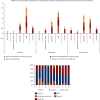Clinical Manifestations, Imaging Features, and Pathogenic/Prognostic Risk Factors for Temporomandibular Disorders (TMD): A Case-Control Study Based on Psychogenic Factors of Patients
- PMID: 35924116
- PMCID: PMC9343186
- DOI: 10.1155/2022/8279357
Clinical Manifestations, Imaging Features, and Pathogenic/Prognostic Risk Factors for Temporomandibular Disorders (TMD): A Case-Control Study Based on Psychogenic Factors of Patients
Retraction in
-
Retracted: Clinical Manifestations, Imaging Features, and Pathogenic/Prognostic Risk Factors for Temporomandibular Disorders (TMD): A Case-Control Study Based on Psychogenic Factors of Patients.Comput Math Methods Med. 2023 Jul 19;2023:9898579. doi: 10.1155/2023/9898579. eCollection 2023. Comput Math Methods Med. 2023. PMID: 37503434 Free PMC article.
Abstract
Objective: To survey the clinical manifestations and imaging features of temporomandibular disorders (TMD) and analyze the risk factors for pathogenesis/prognosis through a case-control study based on psychogenic factors of patients.
Methods: According to the inclusion criteria, 200 adult patients were randomly enrolled from the maxillofacial department of our hospital from January 2020 to May 2021, including 100 patients with TMD as the study group and 100 healthy patients as the control group. The study group can be assigned into four subgroups according to their clinical manifestations: (1) articular area or/and masticatory muscle pain group, (2) mandibular movement abnormality group, (3) joint murmur group, and (4) two or more symptom groups. Based on the study of psychogenic factors of patients, the clinical manifestations and imaging features of TMD were determined, and the risk factors for pathogenesis/prognosis were analyzed.
Results: The distribution of psychological status in the TMD group was higher than that in the control group (P < 0.05). The distribution of anxiety, depression, and somatic symptoms in the TMD group was significantly different from that in the control group (P < 0.05). Anxiety, depression, and somatic symptoms were the risk factors for TMD. Compared with the control group, the incidence of abnormal MRI images in patients with temporomandibular disorders was significantly different (P < 0.05). There were significant differences in psychological status (anxiety, depression, and somatic symptoms) among the three groups (P < 0.05). Anxiety, depression, and somatic symptoms were the risk factors for abnormal mandibular movement and joint tremor and murmur (P < 0.05). Somatic symptoms were the risk factors for various clinical symptoms of TMD (P < 0.05). Depression was the risk factor for pain (P < 0.05).
Conclusion: In patients with TMD, MRI can early identify disc abnormalities and other related imaging features, which is helpful for more comprehensive clinical evaluation and treatment of TMD patients. There exhibits no significant difference in psychological status (anxiety, depression, and somatic symptoms) of patients with different clinical symptoms, and abnormal psychological status may be one of the risk factors leading to different clinical symptoms and development of different types of TMD patients.
Copyright © 2022 Sunqiang Hu et al.
Conflict of interest statement
The authors declare that they have no conflicts of interest.
Figures






Similar articles
-
[Clinical investigation and research on Axis Ⅱ evaluation of patients with temporomandibular disorders].Zhonghua Kou Qiang Yi Xue Za Zhi. 2022 Jan 9;57(1):76-84. doi: 10.3760/cma.j.cn112144-20210604-00282. Zhonghua Kou Qiang Yi Xue Za Zhi. 2022. PMID: 35012255 Chinese.
-
[Application of psychological scales recommended by DC/TMD in patients with temporomandibular joint disorders].Shanghai Kou Qiang Yi Xue. 2023 Feb;32(1):109-112. Shanghai Kou Qiang Yi Xue. 2023. PMID: 36973855 Chinese.
-
Pregnancy related factors and temporomandibular disorders evaluated through the diagnostic criteria for temporomandibular disorders (DC/TMD) axis II: a cross sectional study.BMC Oral Health. 2024 Feb 13;24(1):226. doi: 10.1186/s12903-024-03930-6. BMC Oral Health. 2024. PMID: 38350935 Free PMC article.
-
Pharmacotherapy in Temporomandibular Disorders: A Review.J Can Dent Assoc. 2017 Jul;83:h7. J Can Dent Assoc. 2017. PMID: 29513209 Review.
-
Painful Temporomandibular Disorder: Decade of Discovery from OPPERA Studies.J Dent Res. 2016 Sep;95(10):1084-92. doi: 10.1177/0022034516653743. Epub 2016 Jun 23. J Dent Res. 2016. PMID: 27339423 Free PMC article. Review.
Cited by
-
Accurate Diagnosis and Treatment of Painful Temporomandibular Disorders: A Literature Review Supplemented by Own Clinical Experience.Pain Res Manag. 2023 Jan 31;2023:1002235. doi: 10.1155/2023/1002235. eCollection 2023. Pain Res Manag. 2023. PMID: 36760766 Free PMC article. Review.
-
Diagnosis and Treatment of Myogenous Temporomandibular Disorders: A Clinical Update.Diagnostics (Basel). 2022 Nov 23;12(12):2914. doi: 10.3390/diagnostics12122914. Diagnostics (Basel). 2022. PMID: 36552921 Free PMC article. Review.
-
Myogenous Temporomandibular Disorders: Diagnostic Concepts and Prospective Pilot Study on Extracorporeal Shockwave Therapy.Diagnostics (Basel). 2022 Dec 24;13(1):51. doi: 10.3390/diagnostics13010051. Diagnostics (Basel). 2022. PMID: 36611343 Free PMC article.
-
Retracted: Clinical Manifestations, Imaging Features, and Pathogenic/Prognostic Risk Factors for Temporomandibular Disorders (TMD): A Case-Control Study Based on Psychogenic Factors of Patients.Comput Math Methods Med. 2023 Jul 19;2023:9898579. doi: 10.1155/2023/9898579. eCollection 2023. Comput Math Methods Med. 2023. PMID: 37503434 Free PMC article.
References
-
- Hanna R., Dalvi S., Bensadoun R. J., Benedicenti S. Role of photobiomodulation therapy in modulating oxidative stress in temporomandibular disorders. A systematic review and meta-analysis of human randomised controlled trials. Antioxidants . 2021;10(7):1028–1569. doi: 10.3390/antiox10071028. - DOI - PMC - PubMed
Publication types
MeSH terms
LinkOut - more resources
Full Text Sources
Medical

